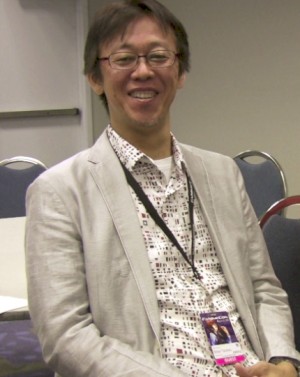The Works of Takahiro Omori
May 15, 2015 · 0 comments
By Andy Hanley
 For fans of the works of light novel author Ryohgo Narita, 2015 is turning into an exciting year – his original Durarara novels are getting an official English release from Yen Press, a second season of the anime adaptation of that series – Durarara x2 – is airing over the next twelve months split into three blocks of twelve episodes, and of course UK anime fans have the first season of Durarara available to purchase, with the anime adaptation of Narita’s other major work Baccano also on the way on Blu-ray.
For fans of the works of light novel author Ryohgo Narita, 2015 is turning into an exciting year – his original Durarara novels are getting an official English release from Yen Press, a second season of the anime adaptation of that series – Durarara x2 – is airing over the next twelve months split into three blocks of twelve episodes, and of course UK anime fans have the first season of Durarara available to purchase, with the anime adaptation of Narita’s other major work Baccano also on the way on Blu-ray.
In terms of the growth of western fandom for both of these series however, there’s no shortage of credit that should be steered towards another individual – Takahiro Omori, the man responsible for directing both Baccano and Durarara‘s animated outings and someone with a notable career within the industry spanning thirty years and a variety of impressive works.
Omori’s work can be traced back to the mid-1980s, where (like many directors) he began his career as an animator, with his most notable work of that time involving key animation duties on the final two episodes of GAINAX’s classic OVA Gunbuster, as well as Nadia: The Secret of Blue Water.
Having turned his attention towards directorial duties in the 1990s, it’s not until 2002 that Omori appeared on the radar of western fans courtesy of Haibane Renmei, where he served as assistant director while also involving himself with storyboards and episode direction. Given the quiet, dramatic and intensely character-driven focus of that series, it could certainly be argued that Omori’s work here served him in good stead as a precursor to his later works and a trademark style which often relies heavily on that exact same set of values.
 Omori’s next works as a fully-fledged director continued down a similarly character-driven path, as his work on romantic dramas Koi Kaze and Gakuen Alice then led him – notwithstanding two seasons of Hell Girl – to 2007 and the sprawling, complex web spun around an ensemble cast of characters that is Baccano. Bringing a multi-faceted story into which those characters are all woven to the small screen is no mean feat, but Baccano‘s anime outing achieved it with aplomb to create a memorable series, while also setting the scene for Omori to return to the director’s chair for the adaptation of Narita’s next light novel project a few years later. Also of note is that Takahiro Omori was responsible for creating the storyboards for the series’ opening credit sequence – a joyously slick and inventive introduction to the show’s cast and setting that has become iconic in its own right.
Omori’s next works as a fully-fledged director continued down a similarly character-driven path, as his work on romantic dramas Koi Kaze and Gakuen Alice then led him – notwithstanding two seasons of Hell Girl – to 2007 and the sprawling, complex web spun around an ensemble cast of characters that is Baccano. Bringing a multi-faceted story into which those characters are all woven to the small screen is no mean feat, but Baccano‘s anime outing achieved it with aplomb to create a memorable series, while also setting the scene for Omori to return to the director’s chair for the adaptation of Narita’s next light novel project a few years later. Also of note is that Takahiro Omori was responsible for creating the storyboards for the series’ opening credit sequence – a joyously slick and inventive introduction to the show’s cast and setting that has become iconic in its own right.
The director continued to make his mark at production studio Brain’s Base with another pair of notable, character-driven manga adaptations in the form of Natsume’s Book of Friends and Princess Jellyfish, swapping mafia gangs for yokai and obsessive otaku girls respectively. Natsume’s Book of Friends in particular served as a perfect example of the director’s deftness of touch when handling more delicate, intricate subject matter where a character’s thoughts and feelings may run directly contrary to one another. This adaptation impressed the original manga author Yuki Midorikawa sufficiently for her to return to Brain’s Base and Omori to direct a short film based on another of her works, Hotarubi no Mori e, which some readers might remember from its screening at Scotland Loves Anime back in 2011. Meanwhile, Princess Jellyfish rose above a weak ending to prove memorable in its own right, not least for another wonderfully inventive opening credits sequence storyboarded by Omori himself that playfully riffed on a number of blockbuster Hollywood films.
 In-between those two series was, of course, the first season of Durarara – while Baccano‘s adaptation enjoyed critical acclaim and a small, dedicated fan base, Durarara‘s popularity was explosive in both Japan and beyond. Swapping 1930s America for modern-day Japan and Tokyo’s Ikebukuro district, yet retaining the core premise of an ensemble character drama where anything goes from street gangs to a Dullahan straight out of Irish mythology, Durarara is a masterclass in patient story-telling. Allowing its cast plenty of room to breathe and become familiar to the viewer before guiding them through its occasionally complex world, the series also has a number of big reveals up its sleeve, and thanks to a breadth to its story and characters that allow it to shift seamlessly between comedy and larger than life dramatic moments it’s ceaselessly compelling.
In-between those two series was, of course, the first season of Durarara – while Baccano‘s adaptation enjoyed critical acclaim and a small, dedicated fan base, Durarara‘s popularity was explosive in both Japan and beyond. Swapping 1930s America for modern-day Japan and Tokyo’s Ikebukuro district, yet retaining the core premise of an ensemble character drama where anything goes from street gangs to a Dullahan straight out of Irish mythology, Durarara is a masterclass in patient story-telling. Allowing its cast plenty of room to breathe and become familiar to the viewer before guiding them through its occasionally complex world, the series also has a number of big reveals up its sleeve, and thanks to a breadth to its story and characters that allow it to shift seamlessly between comedy and larger than life dramatic moments it’s ceaselessly compelling.
It’s taken five years for Durarara to return to our screens, with many of the show’s production staff including its director moving away from Brain’s Base to a brand new studio, Shuka, to work on Durarara x2. In the meantime, Omori took the helm on an original work for Manglobe in the form of Samurai Flamenco, which aired in Japan on Fuji Television’s noitaminA slot. This proved to be a suitable home for a series that dared to be different in what initially starts out as the story of a young man determined to be a superhero without having any superpowers to speak of, but ultimately accelerates into increasingly insane territory before taking its madness all the way through to its logical conclusion. The shifting sands of its premise, and its obvious place as a love letter to Super Sentai series, may not have been to everyone’s tastes, but Samurai Flamenco‘s imaginative train of thought and dedication to having as much fun as possible with every story element it introduced ultimately served it in good stead as another notable notch on Omori’s belt.
For all of these other gems throughout his career though, it’s surely for Baccano and Durarara that Takahiro Omori is most fondly regarded – hardly a surprise, given the rich world and larger than life characters that he has played such a major part in bringing to life.
Andy Hanley is editor-in-chief of the UK Anime Network. Durarara is available to purchase on DVD and Blu-ray from Anime Limited. Baccano is coming to the UK on Blu-ray from Anime Limited later this year. Samurai Flamenco is currently available in streaming form on Netflix UK
Leave a Reply